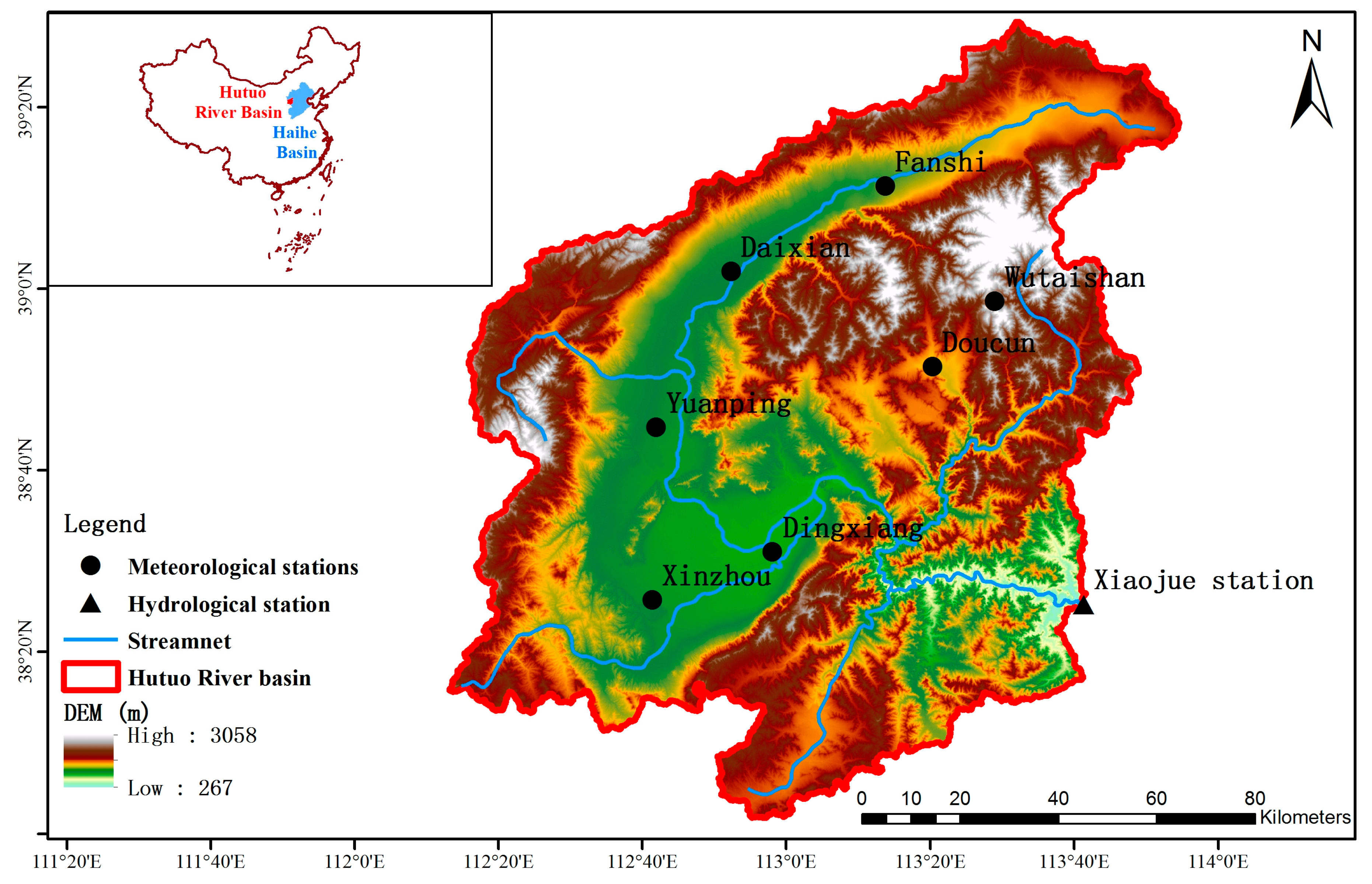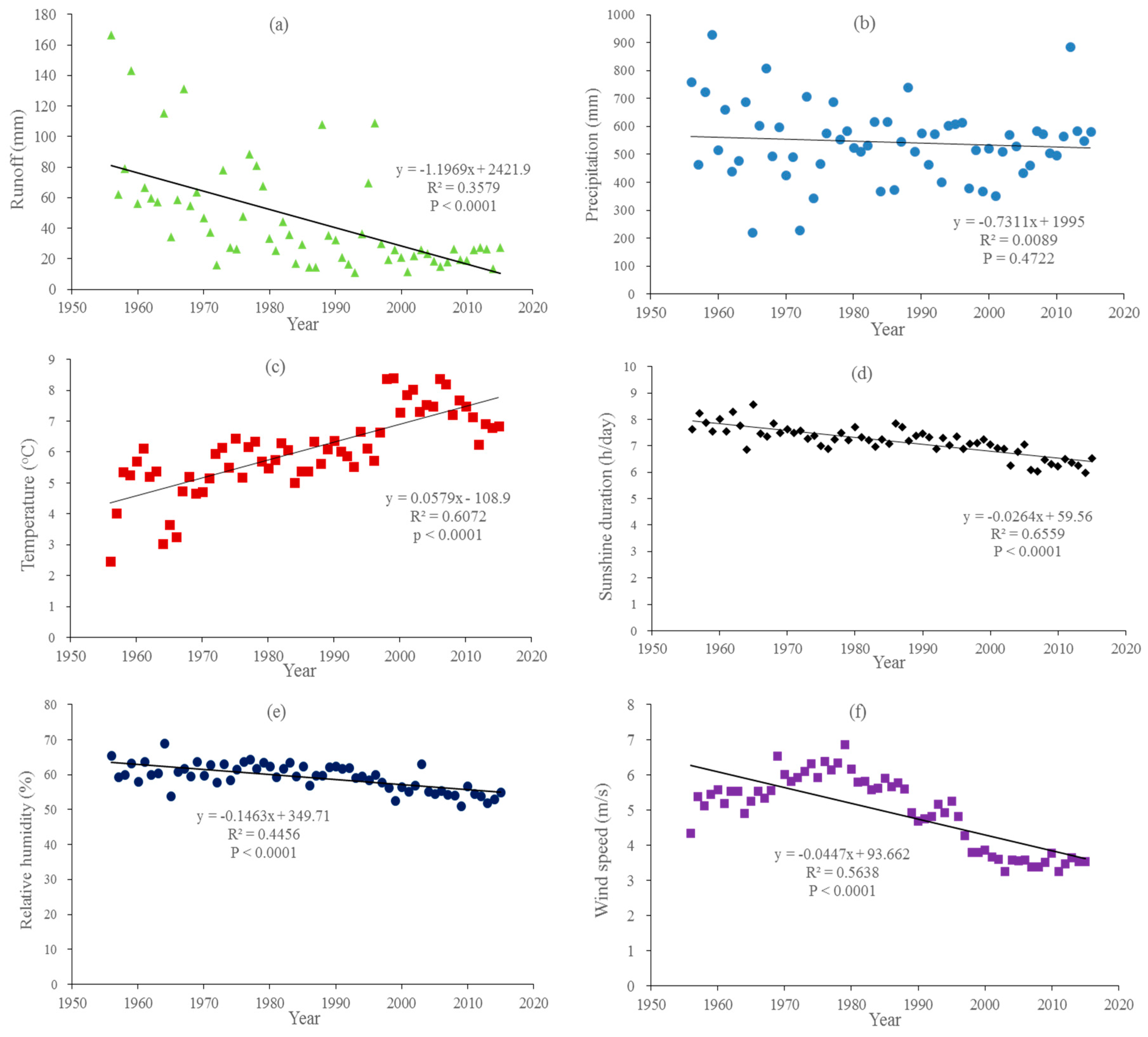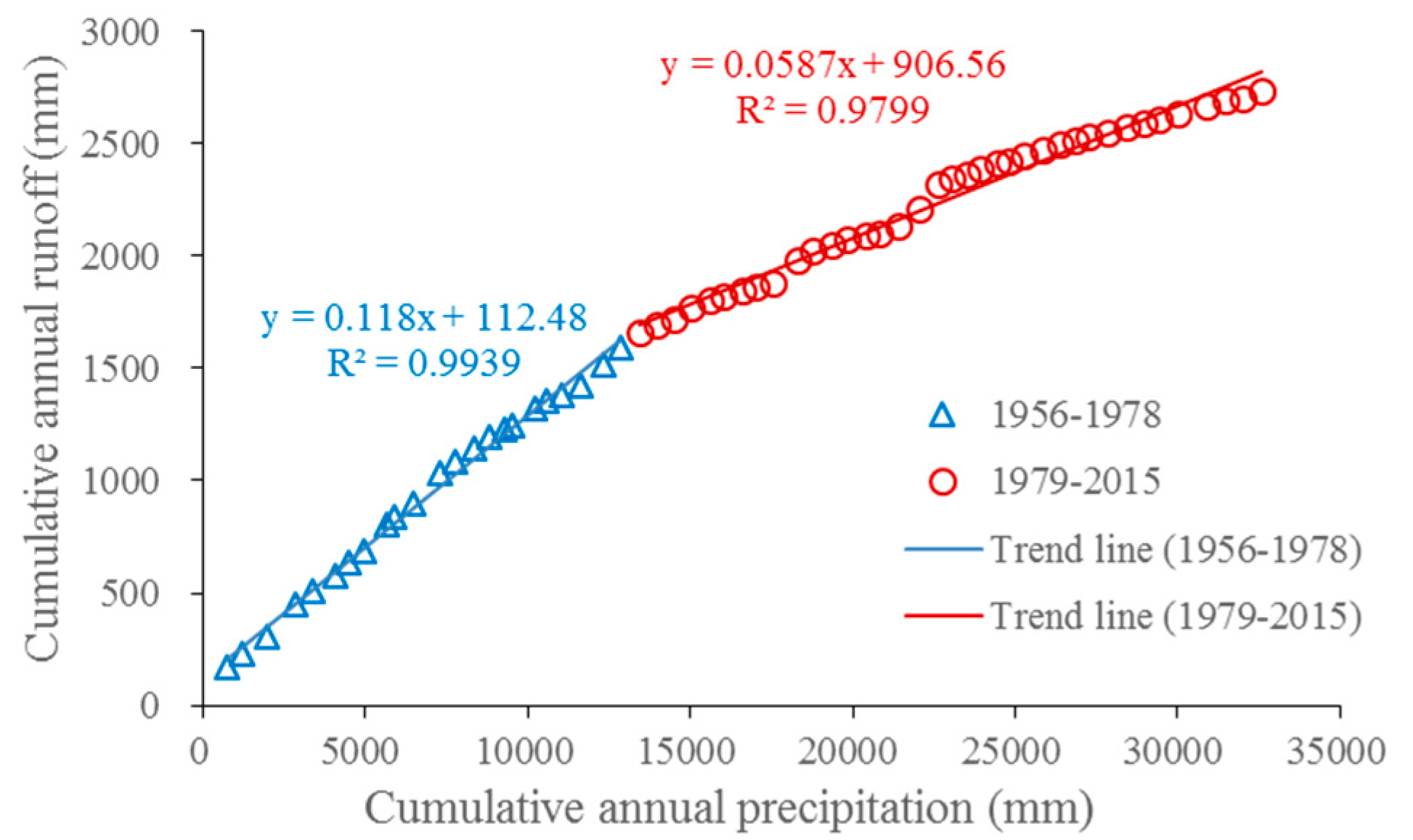1. Introduction
In recent decades, climate change has attracted increasing global attention because the changing climate could affect water supplies [
1,
2]. The Intergovernmental Panel on Climate Change (IPCC, 2013) Fifth Assessment Report on Climate Change noted that the global average temperature increased by 0.85 °C from 1880 to 2013 [
3]. Spatial and temporal changes in precipitation (P) have been observed in many parts of the world [
4,
5,
6]. Runoff (R) is one of the most important components of the water cycle and is affected by climate change. River R and water resources have changed in many parts of the world due to climate change [
7,
8,
9,
10]. Climate change affects water resources and threatens agricultural production in China [
11]. Understanding how much of the observed change in R can be attributed to climate change is important to water resource management.
A tremendous importance has been attached to the study of climatological variables, such as air temperature (T), amount of P, sea level, and atmospheric pressure [
12]. The study of annual precipitation and mean annual temperature in the state of Kentucky indicates that, over the period 1950–2010, the precipitation generally did not exhibit any statistically significant trends with respect to time [
4]. Generally, the average total annual P in China has not changed remarkably; however, regional and seasonal distinctions in P are evident [
13,
14]. A wet tendency has been identified in South China, and a dry tendency has been identified in North China, with the wet tendency in winter and the dry tendency in summer [
6]. There was a consistent warming trend throughout the country during the period of 1963–2012, with a warming rate of 0.26 °C/decade [
15]. Tian et al. used the extreme T indices to detect significant and stable trends in the southern Anhui and Jiangsu provinces [
16]. The mean annual T increased significantly, with a rate of 0.0247 °C per year; additionally, the mean winter T increased by 0.0353 °C per year, and the increasing trend in winter was more significant than those in other seasons between 1961 and 2012 in the southeast Tibetan Plateau [
17]. The annual mean temperature in the Loess Plateau has significantly increased over the last 50 years (1.91 °C/50 years.); however, the region-averaged annual P showed a nonsignificant negative trend (−29.11 mm/50 years.) [
18]. Many studies have focused on the spatial distribution and temporal trends in P and T among years and seasons, and the trends in climate variability as well as their magnitudes were spatially and temporally variable. However, most studies have concentrated on the spatial and temporal distribution of P and T; few studies have provided insight into the seasonal and monthly changes in P and T. In addition, the variation analyses of other climatic elements, such as sunshine duration (SD), relative humidity (RH), and wind speed (WS), are rarely reported.
Recently, several studies have assessed the impacts of climate change on R reduction, and the use of hydrological models to quantify the impacts of climate change and human activity on declines in R has increased. Jia et al. used a distributed hydrological model of water and energy transfer processes in large river basins to assess the impacts of climate change and human activity on the evolution of the quantity of water resources in the highly water-stressed Haihe River basin; their results indicated that natural climate variability and local human activity may be two factors responsible for the observed changes in the quantity of water resources measured between 1961 and 2000 in the basin [
19]. Hu et al. used the HydroInformatic Modelling System (HIMS) to assess the impacts of climate variability and human activities on streamflow in the water source area of Baiyangdian Lake; as a result, the authors found that the effect of human activities played a dominant role in the decline of streamflow in the water source area of Baiyangdian Lake [
20]. However, hydrological models are always limited since they require large amounts of data (e.g., topography, land-use, soil, and hydrometeorological data); additionally, hydrological models are time-consuming in terms of the model calibration and validation processes, and there is uncertainty in terms of model structure and parameter estimation. Accordingly, some new methods have been developed to assess the impacts of climate change and human activities; these new methods include the hydrological sensitivity analysis method, the climate elasticity method, and the slope change ratio of accumulative quantity method.
On a watershed scale, the climate elasticity of R has been considered as an important indicator for quantifying the sensitivity of R to climate change [
21,
22,
23,
24,
25], and this method is advantageous because it requires only the means and trends in climatic and basin variables and does not require extensive historical measurements [
26]; thus, the climate elasticity method has been widely used in quantifying the effects of climatic factors on R, e.g., in the Yellow River basin [
24,
25], the Songhua River basin [
27], the Chao–Bai River basin [
28], the Hai River basin [
25,
29], the entire United States [
22], the 219 catchments across Australia [
30], and 725 catchments in Europe [
31].The concept of climate elasticity was defined by Schaake (1990) to evaluate the effect of P on R [
21].
where
is the P elasticity.
P and T are two of the most important climatic elements and represent a crucial part of the global hydrological cycle [
32]. To further consider the impact of T on R, Ma et al. added T into Equation (1) to calculate the impacts of P and T on R [
28].
where
is the T elasticity.
Additionally, several studies have used the long-term water balance equation (R = P − E) and the Budyko hypothesis to calculate the P elasticity and to assess the effect of climate change on R [
20,
27]. To date, in most studies, P and T are the two key factors considered in assessing the causes of R change, partly because increasing air T is the most significant characteristic of climate change, and P is the major source of R [
33]. Nonetheless, other climatic factors, such as SD, RH, and WS, may play non-negligible roles in R variation; specifically, these additional climatic factors may be important if they change significantly or if R is sensitive to them. Consequently, assessing the impact of climate change on R should consider additional climatic factors. Moreover, much attention has been focused on investigating the variation of annual hydroclimatic series, but few have provided insight into the seasonal and monthly changes in hydroclimatic series and their impacts on runoff change.
In this study, the Hutuo River basin (HTRB) was chosen to assess the change in R as a result of the changing climate. The HTRB is a primary tributary in the west region of the Haihe River basin. The Haihe River basin is an important political and economic center with a large grain production base, and the basin plays an important role in the sustainable development of the economy and the ecology of China. However, frequent droughts and serious water shortages in this basin have hindered economic development and have resulted in severe environmental problems, which are attributable to the region’s environmental and ecological vulnerability to water shortages [
34,
35,
36].
The objective of this study is to use the long-term hydroclimatic time series data (i.e., from 1956 to 2015) to assess the impact of climate variability on R in the HTRB. First, the hydroclimatic changes in the annual, seasonal, and monthly variation of the R and climatic elements (e.g., P, T, SD, RH, and WS) in the HTRB are investigated. Second, we develop a derivation of the climate elasticity of R to climatic elements (e.g., P, T, SD, RH, and WS) based on the climate elasticity method, and then we calculate the contribution of each climatic element to the change in R in the HTRB. This study will help researchers understand the interactions between climate change and hydrological processes at the basin scale and promote water resource management and watershed planning.
5. Conclusions
In this paper, we used the climate elasticity method to assess the contributions of climatic factors on annual and seasonal R change for the period of 1956–2015 in the HTRB. We first investigated the characteristics of changes in annual, seasonal, and monthly hydroclimatic variables, including R, P, T, SD, RH, and WS, during the period of 1956–2015 in the HTRB. Based on the change point of annual R in the HTRB, the whole study period, i.e., from 1956 to 2015, was divided into two periods, the baseline and change periods. The differences in R, P, T, SD, RH, and WS between the two periods were then calculated. The impacts of each climatic factor on R change were discussed based on the climate elasticity method. The main conclusions are summarized below:
Significant downward trends were found for annual R, SD, RH, and WS; additionally, P also decreased but did not pass the 0.05 level of significance test. In contrast, T increased significantly, with a rate of 0.58 °C/10a. On the seasonal scale, the R, SD, RH, and WS in four seasons all significantly decreased. T showed a significant warming trend in all four seasons. P significantly increased in spring and winter, and P decreased in summer and autumn, though this decrease was insignificant.
The cumulative anomaly test and the P-R double cumulative curve demonstrated that annual R showed an abrupt change in 1979. Thus, the whole study period, i.e., from 1956 to 2015, was divided into two periods, the baseline period (1956–1978) and the change period (1979–2015).
Based on the climate elasticity method, the climate elasticities of climatic factors were calculated, and the values of , , , , and were 1.84, −1.07, −2.79, 1.73, and −0.45, respectively; additionally, the contribution of each climatic factor to the decline in R was 10.3%, 34.4%, −30.2%, 12.1%, and −12.4%, respectively. In the HTRB, the increase in T was the main cause of the decline in R, while SD largely negatively contributed to the R decline. In terms of seasonal, R change was dominated by T and RH in spring, P in summer, RH and P in autumn, and SD and WS in winter.
This study points out the necessity of researching hydrological and climate change in the HTRB and investigates the impact of five climate factors on runoff change by the climate elasticity method and highlights the necessity of investigating runoff responses to climatic elements other than the precipitation and temperature. However, the meteorological data in the high elevation are scarce, more comprehensive and in-depth analyses may be needed for future studies by using the remote sensing data.











